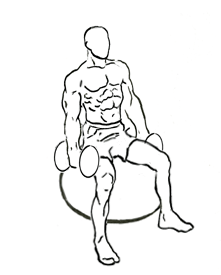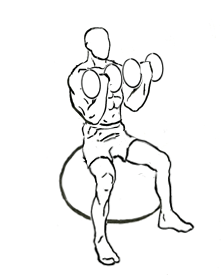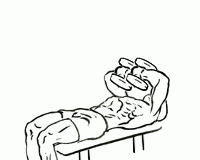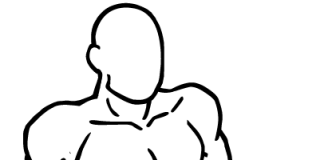Last Updated on September 30, 2022
Bicep curls are one of the most classic and effective exercises for targeting and strengthening the biceps. They’re simple, accessible, and can be done almost anywhere with just a pair of dumbbells. While the traditional standing or seated curl on a bench is a staple in most workout routines, you can take it to the next level by incorporating a stability ball into your exercise.
This not only challenges your biceps but also activates your core muscles, improves your posture, and enhances your balance and stability. In this blog, we’ll explore everything you need to know about performing a Biceps Curl Seated on Stability Ball with Dumbbell—from its benefits to the step-by-step guide on how to execute it correctly.
Why Use a Stability Ball for Biceps Curls?
Before we get into the specifics of the exercise, let’s first understand why using a stability ball is beneficial in the first place.
A stability ball, also known as a Swiss ball or exercise ball, is a large, inflatable ball used in various fitness exercises. What makes it so versatile is its unstable surface, which forces your body to engage more muscles—especially your core and stabilizer muscles—to maintain balance. This is why you often see stability balls in exercises designed to target the abs, lower back, and even legs.
Incorporating a stability ball into upper body exercises, like biceps curls, turns a straightforward arm workout into a full-body effort. Your core muscles, including your abs and lower back, are engaged throughout the movement to keep you stable, and your posture naturally improves as your body adjusts to the unstable surface of the ball.
Benefits of Performing Biceps Curl Seated on Stability Ball with Dumbbell
Here are some key benefits of incorporating a stability ball into your biceps curl routine:
- Core Activation: When seated on a stability ball, your core is forced to engage to keep your body stable and balanced. This makes the exercise not just a biceps workout but a full-body challenge.
- Improved Posture: Since the ball is unstable, your body has to work harder to maintain proper posture throughout the exercise. This can help improve your overall body alignment and reduce the risk of slouching.
- Enhanced Balance and Stability: The stability ball challenges your sense of balance, which means you’ll improve your coordination and stability as you perform the curls.
- Reduced Pressure on the Spine: Seated on a stability ball, the natural curvature of your spine is supported, helping to alleviate pressure on your lower back.
- Increased Muscle Engagement: Not only are your biceps engaged during the curl, but your shoulders, back, and even legs are activated to help stabilize your body.
Now that we understand the benefits, let’s dive into the steps to correctly perform this variation of the biceps curl.
Step-by-Step Guide to Seated Biceps Curls on a Stability Ball
Equipment Needed:
- A pair of dumbbells (choose a weight that’s challenging but manageable for you)
- A stability ball
Starting Position:
- Set Up the Stability Ball: Begin by selecting the correct stability ball size. When seated on the ball, your hips and knees should form a 90-degree angle, with your feet flat on the floor. This ensures that you are properly positioned and stable for the exercise.
- Sit on the Ball: Sit down on the stability ball with your feet placed shoulder-width apart. Keep your feet firmly planted on the ground, about 6–8 inches in front of the ball. Your knees should be bent at 90 degrees, with your thighs parallel to the floor. Keep your core muscles engaged by drawing in your belly button toward your spine. This engagement will help with balance and posture throughout the movement.
- Hold the Dumbbells: Grasp a dumbbell in each hand using an underhand grip (palms facing upward). Your arms should be fully extended at your sides, with your palms facing forward. Keep your elbows close to your torso, and maintain a straight back throughout the exercise.
Performing the Curl:
- Start the Curl: Begin by slowly curling the dumbbells upward towards your shoulders. Keep your elbows stationary at your sides—only your forearms should be moving. Focus on engaging your biceps as you lift the weights. Exhale as you lift the dumbbells.
- Pause and Squeeze: When you’ve reached the top of the movement (with the dumbbells near your shoulders), pause for a second and squeeze your biceps. This brief pause increases muscle engagement and intensifies the workout.
- Lower the Dumbbells: Slowly lower the dumbbells back down to the starting position. It’s essential to control the movement during this phase. Don’t let the weights drop quickly—use your muscles to guide them down steadily. Inhale as you lower the dumbbells.
- Repeat: Perform the desired number of repetitions (typically 10–15) per set. Focus on maintaining proper form throughout. Avoid swinging your arms or using momentum to lift the weights—this reduces the effectiveness of the exercise and can lead to injury.
Common Mistakes to Avoid:
Like any exercise, form is critical in getting the most out of the movement and preventing injury. Here are a few common mistakes to watch out for during seated biceps curls on a stability ball:
- Slouching or Rounding the Back: Make sure your back stays straight and your chest is lifted throughout the exercise. Slouching not only reduces the effectiveness of the curl but can also put strain on your lower back.
- Using Momentum: Avoid using your body’s momentum to lift the dumbbells. If you find yourself swinging your arms or rocking your body to get the weights up, it may be a sign that the weight is too heavy.
- Elbows Moving Away from the Body: Keep your elbows close to your sides during the entire movement. Allowing your elbows to flare out reduces the tension on the biceps and shifts the focus to other muscles.
- Not Engaging the Core: Don’t forget about your core! Engage your abdominal muscles by drawing your belly button toward your spine to help with balance and stability. This also prevents unnecessary strain on your lower back.
Variations and Modifications
While the basic biceps curl seated on a stability ball is highly effective, there are a few variations you can try to add some variety to your routine and challenge different muscle groups.
1. Alternating Biceps Curl on a Stability Ball
In this variation, instead of curling both dumbbells at the same time, alternate between each arm. This increases the challenge to your core, as it has to work harder to stabilize your body while one arm is curling at a time.
How to Do It:
- Start in the same seated position on the stability ball.
- Curl one dumbbell at a time while keeping the other arm stationary.
- Continue alternating between arms until you’ve completed your reps.
2. Hammer Curl on a Stability Ball
A hammer curl is a variation of the biceps curl where the palms face each other throughout the movement, rather than facing upward. This targets a different part of the biceps and also engages the forearms.
How to Do It:
- Begin seated on the stability ball with a dumbbell in each hand, palms facing inward.
- Curl the dumbbells up to shoulder height while maintaining the same palm-inward position.
- Lower the weights slowly back to the starting position.
3. Concentration Curl on a Stability Ball
For an even more isolated bicep workout, try performing a concentration curl while seated on a stability ball. This variation involves leaning forward slightly and bracing one elbow against the inside of your thigh.
How to Do It:
- Sit on the stability ball and lean forward slightly.
- Hold one dumbbell in your hand and brace your elbow against the inside of your thigh.
- Curl the dumbbell up to your shoulder, focusing on isolating the bicep muscle.
Incorporating the Stability Ball Biceps Curl into Your Routine
Now that you know how to perform this exercise, you might wonder how to fit it into your workout routine. This exercise can be a great addition to both upper body and full-body workout days. Here’s how you can incorporate it:
- As Part of an Upper Body Workout: Add the seated biceps curl to your upper body routine, targeting arms, shoulders, and chest. Perform 3 sets of 10–15 repetitions.
- On Core-Focused Days: Since the stability ball curl engages your core, it can also be included in a core-strengthening day alongside exercises like planks, Russian twists, and stability ball rollouts.
- As a Finisher: If you’re looking to exhaust your biceps at the end of a workout, this can be an excellent finisher. Lower the weight and perform higher reps (15–20 per set) to really burn out the muscles.
Final Thoughts
The biceps curl seated on a stability ball is a fantastic way to add variety and challenge to your arm workout. By incorporating the stability ball, you engage more muscle groups, improve your balance and posture, and work your core—all while strengthening your biceps. Whether you’re a beginner or a seasoned lifter, this exercise can fit into your routine and offer benefits beyond just bigger arms.
So, grab a pair of dumbbells and a stability ball, and give this variation a try in your next workout session!


Exercise images by Everkinetic.






